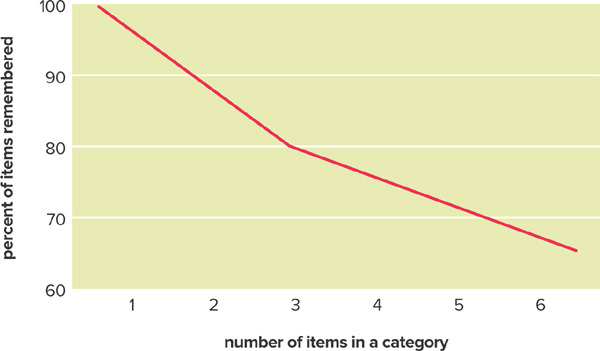9. People Remember Only Four Items At Once
If you’re familiar with usability, psychology, or memory research, you’ve probably heard the phrase ”the magical number seven, plus or minus two.” This refers, actually, to what I would call an urban legend: George A. Miller (1956) wrote a research paper showing that people can remember from five to nine (seven plus or minus two) things and that people can process seven plus or minus two pieces of information at a time. Have you heard that story? Well, it’s not quite accurate.
Why It’s An Urban Legend
Psychologist Alan Baddeley questioned the seven plus or minus two rule. Baddeley (1994) dug up Miller’s paper and discovered that it wasn’t a paper describing actual research; it was a talk that Miller gave at a professional meeting. And it was basically Miller thinking out loud about whether there is some kind of inherent limit to the amount of information that people can process at a time.
Baddeley (1986) had conducted a long series of studies on human memory and information processing. Others followed in his footsteps—Nelson Cowan (2001), for example. The research now shows that the “magical” number is four.
Using Chunks to Turn Four into More
People can hold three or four things in working memory as long as they aren’t distracted and as long as their processing of the information is not interfered with.
One of the interesting strategies people employ to help our fragile memories is “chunking” information together into groups. It’s no accident that US phone numbers look like this:
712-569-4532
Instead of having to remember ten separate numerals, a phone number has three chunks, with four or fewer items in each chunk. If you know the area code by heart (that is, it’s stored in long-term memory), then you don’t have to remember that part of the number, so you can ignore one whole chunk.
Years ago, phone numbers were easier to remember because you mainly called people in your area code, so you didn’t have to hold the area code in working memory; it was in long-term memory, which we will get to shortly. In the good old days, you didn’t even need to use the area code if the number you were calling from was in the same area code as you were dialing from (not true anymore in most places). And to make it even easier, everyone in town had the same exchange (the 569 part of the previous phone number). If you were dialing someone in your town with the same exchange, all you had to remember was the last four numbers. No problem! (I know I’m dating myself here by telling you how it used to be back in the old days. I live now in a small town in Wisconsin, and people here still give their number to others as the last four digits only, even though now you have to use the area code and then all seven numbers.)
The Four-Item Rule Applies to Memory Retrieval too
The four-item rule applies not only to working memory, but also to long-term memory. George Mandler (1969) showed that people could memorize information in categories and then retrieve it from memory perfectly if there were one to three items in a category. The number of items recalled dropped steadily when each category contained more than three items. If there were four to six items in a category, then people could remember 80 percent of the items. It went down from there, falling to 20 percent if there were 80 items in the category (Figure 9.1).
Figure 9.1. The more items there are in a category, the less accurate memory is.
Donald Broadbent (1975) asked people to recall items in different categories—for example, the Seven Dwarfs, the seven colors of the rainbow, the countries of Europe, or the names of current shows on TV. People remembered two, three, or four items clustered together.
Use Chunking In Your Presentation
Many, or even most, presentations have more than three or four ideas and concepts. Instead of having a long list of 12 or 15 different topics, group items so that you have three or four overall topics. These can then be broken up into three or four items each.
For example, here is a list of topics for a presentation on how to start and run a successful small business:
a. Deciding what products and services to offer
b. Deciding how to price your products and services
c. What online marketing is critical for you
d. What person-to-person marketing is critical
e. Do you need to incorporate?
f. What you need to know about taxes
g. Should you hire employees or use contractors?
h. What software to use for invoicing
i. What software to use for email contacts and email marketing
j. Effective sales techniques for small businesses
k. Identifying your target market
l. Designing and implementing a Web site
Instead of using this as your topic list and talking about and showing the list at the beginning of your talk, you could chunk the topics into the following groupings:
• Selling Your Products and Services (which would include a, b, j, and k)
• How To Kick-Start Your Marketing Plan (c, d, i, and l)
• The Business of Your Business (e, f, g, and h)
Each of these major topics could have three or four topics under them, and each topic can be further broken into three or four points. You can now introduce your presentation without overwhelming your audience, and you can provide all the content in digestible chunks.

